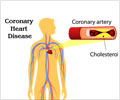Genetic predisposition to higher waist-to-hip ratio adjusted for BMI was associated with greater risk of diabetes and heart disease.

- Abdominal adiposity has been associated with type 2 diabetes and heart disease but the association remains unclear.
- Body fat distribution, beyond simple measurement of //BMI, could explain part of the variation in risk of type 2 diabetes and CHD.
- Waist-to-hip ratio adjusted for BMI might prove useful as a biomarker for diabetes and heart disease.
In observational studies, abdominal adiposity has been associated with type 2 diabetes and CHD. Whether these associations represent causal relationships remains uncertain.
Sekar Kathiresan, M.D., of Massachusetts General Hospital, Harvard Medical School, Boston, and colleagues examined whether a genetic predisposition to increased waist-to-hip ratio adjusted for BMI was associated with cardiometabolic quantitative traits (i.e., lipids, insulin, glucose, and systolic blood pressure), type 2 diabetes and CHD.
Based on a combined data set consisting of summary results from 4 genome-wide association studies conducted from 2007 to 2015 and cross-sectional data from the UK Biobank collected from 2007-2011, the cardiac co-morbidities were examined.
The researchers found that genetic predisposition to higher waist-to-hip ratio adjusted for BMI was associated with increased levels of quantitative risk factors (lipids, insulin, glucose, and systolic blood pressure) as well as a higher risk for type 2 diabetes and CHD.
"Second, these results suggest that body fat distribution, beyond simple measurement of BMI, could explain part of the variation in risk of type 2 diabetes and CHD noted across individuals and subpopulations. Third, waist-to-hip ratio adjusted for BMI might prove useful as a biomarker for the development of therapies to prevent type 2 diabetes and CHD."
- Sekar Kathiresan et al., Findings suggest causal association between abdominal fat and development of type 2 diabetes, coronary heart disease, JAMA (2017).
Source-Medindia















